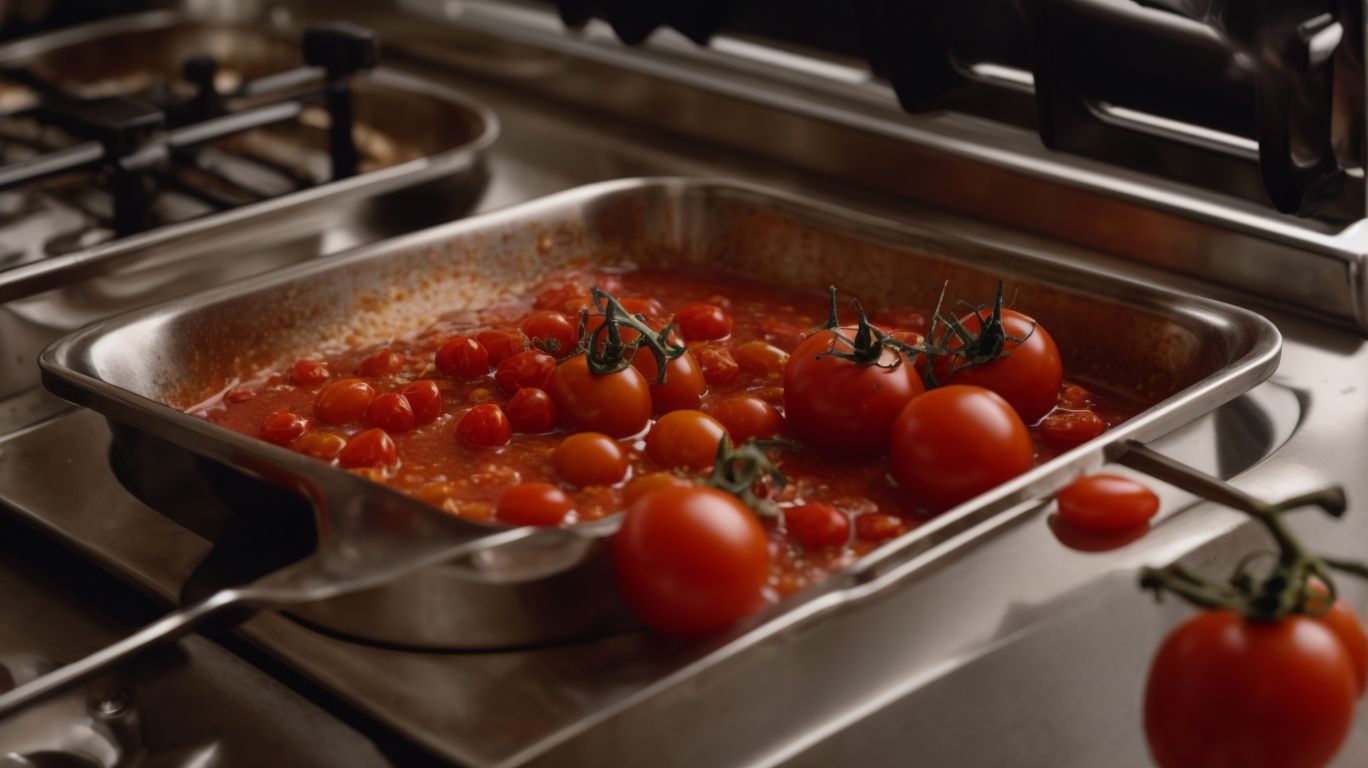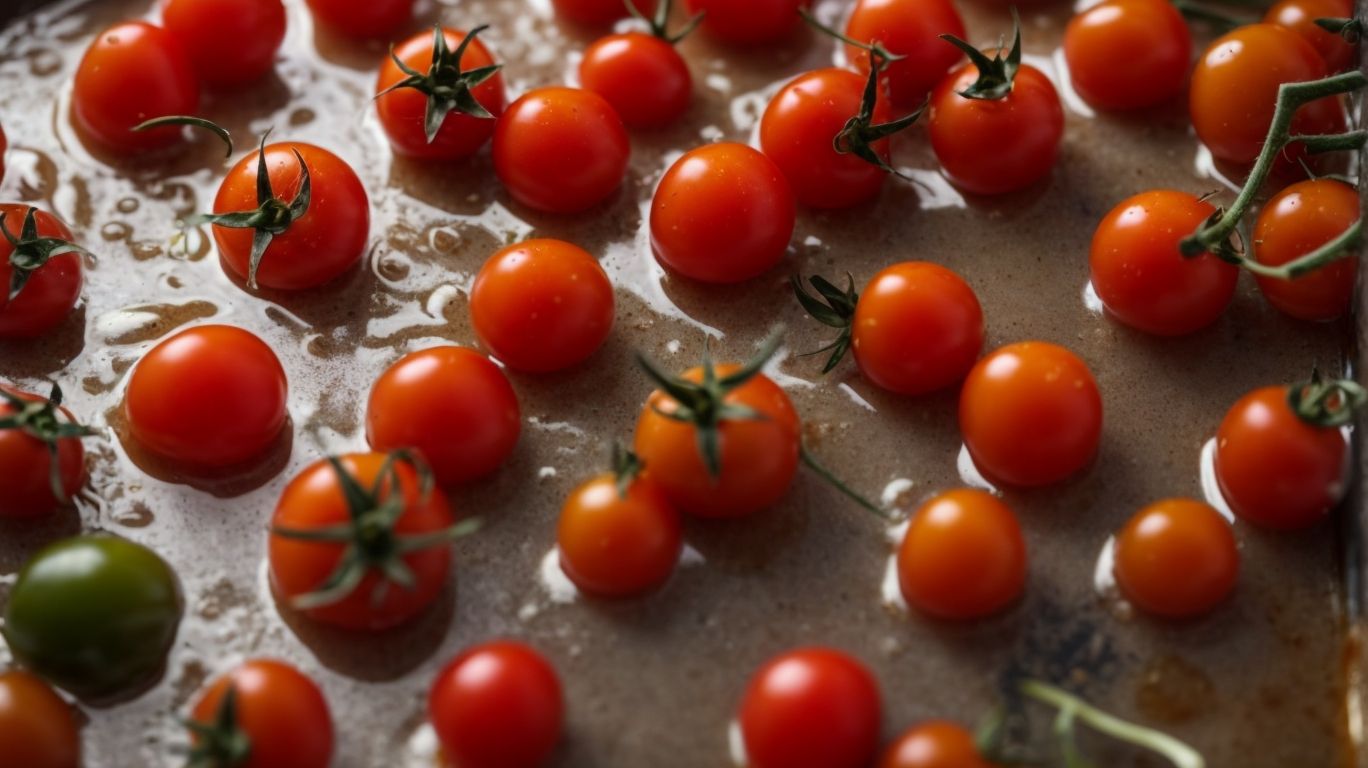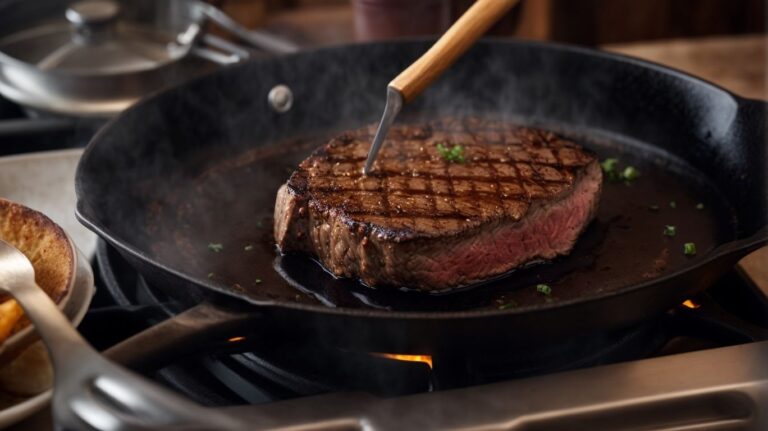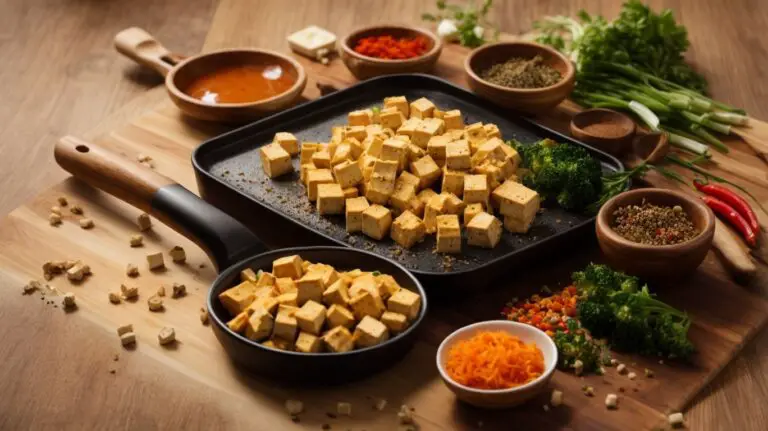How to Cook Cherry Tomatoes Into Sauce?
Are you looking to elevate your culinary skills and add a burst of flavor to your dishes? Look no further than cherry tomatoes!
In this article, we will explore the different types of cherry tomatoes and their nutritional value. We will also provide a step-by-step guide on how to choose the best cherry tomatoes for sauce, along with the other essential ingredients needed.
Stay tuned for tips on making the perfect cherry tomato sauce and creative ways to incorporate it into your favorite recipes. Let’s get cooking with cherry tomatoes!
Key Takeaways:
What are Cherry Tomatoes?
Cherry tomatoes are small, bite-sized fruits that belong to the tomato family, known for their sweet flavor and vibrant color.
These petite tomatoes come in various colors, including red, yellow, and even striped varieties, adding a pop of color to salads, pasta dishes, and appetizers. Their thin skin and juicy interior make them a popular choice for snacking or incorporating into recipes like bruschetta, caprese salad, or roasted vegetable medleys. Due to their high sugar content, they caramelize beautifully when roasted, enhancing the depth of flavor in dishes. Their versatile nature allows them to be used in both raw and cooked forms, enriching the taste profile of numerous culinary creations.”
Types of Cherry Tomatoes
Regarding cherry tomatoes, there are several types available, including grape tomatoes, pear tomatoes, and yellow cherry tomatoes, each offering a unique flavor profile and culinary application.
Grape tomatoes, such as the popular “Sungold”, are typically sweet and tangy, perfect for snacking or adding a burst of flavor to salads.
- Pear tomatoes, on the other hand, have a slight pear shape and a delightful balance of sweetness and acidity, making them ideal for roasting or creating a vibrant tomato sauce.
- Yellow cherry tomatoes, like the “Sunsugar” variety, are known for their golden hue and exceptional sweetness, great for fresh salsas or pairing with creamy cheeses.
Each type of cherry tomato brings its own distinct characteristics to the table, adding variety and color to a range of dishes.”
Nutritional Value of Cherry Tomatoes
Cherry tomatoes are not only delicious but also packed with essential nutrients such as vitamin C, potassium, and antioxidants, making them a healthy addition to your diet.
These vibrant red gems are low in calories and high in fiber, aiding in digestion and promoting a feeling of fullness. The antioxidants found in cherry tomatoes play a crucial role in reducing inflammation and protecting cells from damage.
Along with their nutritional value, cherry tomatoes are versatile in the kitchen. You can enjoy them raw in salads, on skewers, or roasted to bring out their natural sweetness. Incorporating these little powerhouses into your meals can elevate the taste and provide numerous health benefits.
How to Choose the Best Cherry Tomatoes for Sauce?
Selecting the best cherry tomatoes for a flavorful sauce involves considering factors like ripeness, firmness, and color to ensure optimal taste and texture in your dish.
When choosing cherry tomatoes for your sauce, look for ones that are fully ripe but still have a bit of firmness when gently squeezed. Ripe cherry tomatoes typically have a deep, vibrant color, such as a bright red or yellow, signaling their readiness for a delicious sauce.
The aroma of a ripe cherry tomato should be sweet and slightly earthy, indicating that it’s bursting with flavor. When you pick up a ripe cherry tomato, it should feel heavy for its size and have a plump texture, promising a rich and luscious sauce.
What Other Ingredients Do You Need for the Sauce?
Along with cherry tomatoes, a classic cherry tomato sauce recipe typically includes garlic, olive oil, salt, pepper, fresh basil, and grated parmesan cheese for a burst of flavor and richness.
Garlic, known for its pungent aroma and savory taste, serves as a staple in enhancing the savory notes of the sauce.
Olive oil not only acts as a base for cooking but also imparts a subtle fruitiness to complement the sweetness of the cherry tomatoes.
The balance of salt and pepper brings out the natural flavors of all ingredients, harmonizing the overall profile.
Fresh basil adds a touch of freshness and herbaceous aroma, elevating the sauce with its vibrant green color.
Grated parmesan cheese, with its nutty and salty undertones, adds a layer of complexity and richness to the sauce.
Step-by-Step Guide to Cooking Cherry Tomatoes into Sauce

Credits: Poormet.Com – Raymond Hernandez
Transforming cherry tomatoes into a delectable sauce involves a series of steps, from sautéing aromatics to adding the tomatoes and seasonings, and finally simmering the sauce to achieve a harmonious blend of flavors.
Roasting the cherry tomatoes before incorporating them into the sauce can enhance their natural sweetness, giving the dish a delightful depth of flavor. During the summer months, when tomatoes are at their peak freshness, their vibrant colors and bold flavors shine through in this simple yet rich sauce. Adding a touch of umami, perhaps through a splash of Worcestershire sauce or a sprinkle of Parmesan cheese, can elevate the complexity of the sauce even further.
Preparing the Tomatoes
Preparing cherry tomatoes for sauce involves washing, halving, and removing the seeds to concentrate their flavor and achieve a smoother texture in the final dish.
Once the cherry tomatoes are prepped, you have the option of roasting them to enhance their sweetness and depth of flavor. Simply toss them in olive oil, salt, and herbs before placing them in the oven until they blister and caramelize.
After roasting, let the cherry tomatoes cool before transferring them to a food processor for blending into a thick, rich sauce.
To preserve this fresh sauce, consider freezing it in ice cube trays for easy portioning or storing in airtight containers in the fridge for immediate use.
Sautéing the Aromatics
Sautéing aromatics like garlic, shallots, and herbs in olive oil creates a flavorful base for the cherry tomato sauce, infusing the dish with aromatic richness and depth of flavor.
The gentle heat of sautéing allows the aromatics to release their essential oils slowly, building layers of flavor in the sauce. Olive oil serves as the perfect carrier, enhancing the natural sweetness of the cherry tomatoes. Pairing with fresh herbs like basil or oregano adds a herbal complexity and freshness to the dish, while balancing the acidity of the tomatoes. The umami-rich combo of garlic and shallots elevates the sauce to a new level, creating a symphony of flavors on the palate.
Adding the Tomatoes and Seasonings
Incorporating roasted cherry tomatoes into the sautéed aromatics along with a blend of seasonings like salt, pepper, and fresh basil elevates the sauce’s flavor profile and creates a harmonious taste experience.
Regarding choosing the right seasonings for your dish, consider the impact each component will have on the overall balance of flavors. The salt enhances the natural sweetness of the cherry tomatoes, while the pepper adds a subtle heat that complements the dish perfectly.
Fresh basil brings a burst of aromatic freshness, infusing the sauce with a fragrant herbaceous note that elevates the entire flavor profile. The combination of these elements creates a rich, complex blend that tantalizes the taste buds.
Simmering the Sauce
Simmering the cherry tomato sauce on low heat allows the flavors to meld together, intensifying the taste and creating a luscious, thick texture ideal for coating pasta or topping pizzas.
During this cooking process, it’s important to stir the sauce occasionally to prevent sticking and ensure even heat distribution. The simmering duration can vary, but typically, allowing the sauce to gently bubble for around 30-45 minutes helps it develop a robust flavor profile. To achieve the desired consistency, you can adjust by adding a splash of water if the sauce becomes too thick or letting it simmer uncovered for a few extra minutes to reduce excess liquid.
Before finishing the sauce, taste it and adjust the seasonings accordingly by adding salt, pepper, or a pinch of sugar to balance the acidity of the tomatoes. For a smoother texture, you can use an immersion blender to puree the sauce or leave it chunky for a rustic feel. To enhance the depth of flavors, incorporate fresh herbs like basil or oregano and a drizzle of high-quality olive oil before serving this versatile sauce as a delectable accompaniment to your favorite appetizers or main dishes.
Tips for Making the Perfect Cherry Tomato Sauce
To create the perfect cherry tomato sauce, consider roasting the tomatoes for added depth, adjusting seasonings to taste, and experimenting with fresh herbs for a burst of flavor in every spoonful.
Along with roasting, another technique to intensify the flavor of the cherry tomato sauce is to slow-cook the mixture over a low heat. This helps the tomatoes break down further, enhancing the richness of the sauce.
Regarding balancing the seasonings, start with a pinch of salt and pepper and gradually adjust to your preference. Remember, it’s easier to add more seasoning than to fix an overly salted sauce.
For incorporating herbs, try a mix of basil, oregano, and thyme for a classic Italian flair. Finishing the sauce with a drizzle of olive oil can also add a luxurious touch.
How to Use Cherry Tomato Sauce in Recipes?
Cherry tomato sauce is a versatile ingredient that can be used in various recipes, such as pasta dishes, chicken or fish entrees, and as a flavorful pizza topping, offering a burst of summer freshness in each bite.
Its vibrant color and rich flavor make it a fantastic base for a variety of seasonings, from garlic and basil to red pepper flakes for an extra kick. Consider incorporating this sauce in your next pasta primavera, drizzling it over grilled shrimp skewers, or using it as a dip for crispy polenta fries. The sweetness of cherry tomatoes intensifies when roasted, creating a deep, caramelized taste that complements roasted vegetables like zucchini and eggplant perfectly.
Pasta Dishes
Cherry tomato sauce pairs beautifully with pasta dishes, creating vibrant and flavorful combinations that highlight the natural sweetness of the tomatoes and the freshness of the herbs.
Regarding selecting the right pasta to complement the chunky texture of the cherry tomato sauce, opt for shapes like penne or fusilli that can capture the rich sauce within their crevices, enhancing every bite with bursts of flavor.
For a visually appealing presentation, sprinkle some freshly grated Parmesan cheese over the pasta, adding a touch of savory complexity. Fresh basil leaves make for an ideal garnish, not only accentuating the dish’s flavors but also providing a delightful pop of color, lending a vibrant finish to the meal.
To elevate the taste profile further, consider serving a side of garlic bread or a crisp green salad alongside the pasta, offering contrasting textures and additional layers of flavor to delight your palate.
Chicken or Fish Dishes
When paired with chicken or fish dishes, cherry tomato sauce imparts a burst of umami-rich flavors that complement the protein’s natural taste, creating a harmonious and satisfying meal experience.
Chicken and fish are versatile proteins that add depth and richness to dishes when combined with cherry tomato sauce. To prepare a delectable meal, start by sautéing your choice of protein in a skillet until perfectly cooked. Then, carefully spoon the vibrant cherry tomato sauce over the protein, allowing the flavors to meld together.
The freshness of the cherry tomatoes brings a burst of acidity, balancing the richness of the meat. For a flavorful twist, consider adding garlic, fresh basil, or a touch of balsamic vinegar to elevate the dish even further.
Pizza Toppings
Using cherry tomato sauce as a pizza topping adds a burst of fresh flavor and vibrant color to the pizza, creating a delightful contrast with cheese and other toppings for a truly satisfying slice.
When paired with mozzarella cheese, the tangy sweetness of the cherry tomato sauce blends harmoniously with the creamy richness of the cheese, creating a classic Italian flavor profile. For those looking to elevate the taste further, crumbled feta cheese sprinkled over the tomato sauce before baking offers a savory punch and a hint of saltiness to the pizza.
Experimenting with different ingredient variations can transform a simple pizza into a gourmet appetizer. Try adding roasted garlic cloves to the cherry tomato sauce for a robust flavor or sprinkling fresh basil leaves over the top for a fragrant finish.
Conclusion
Cherry tomatoes are a versatile ingredient that can be transformed into a delectable sauce, adding a burst of summer freshness and rich flavor to a variety of dishes, from pasta to pizzas.
These vibrant little tomatoes are not only known for their sweetness but also pack a tangy punch, making them a standout choice in sauce-making. When combined with aromatic herbs such as basil, the cherry tomatoes develop a harmonious balance of flavors that elevate any dish they grace. With a touch of grated parmesan cheese, the sauce reaches a whole new level of creamy indulgence.
Whether incorporated into a classic marinara sauce for spaghetti or used as a topping for bruschetta, cherry tomatoes bring a pop of color and freshness that is sure to impress any palate. Their versatility allows them to shine in soups, salads, and even grilled dishes, showcasing their dynamic taste profile.
Frequently Asked Questions
What ingredients do I need to cook cherry tomatoes into sauce?
To cook cherry tomatoes into sauce, you will need cherry tomatoes, olive oil, garlic, salt, pepper, and fresh herbs (optional).
Can I use canned cherry tomatoes to make sauce?
Yes, you can use canned cherry tomatoes to make sauce. However, the flavor may not be as fresh as using fresh cherry tomatoes.
How do I properly store leftover cherry tomato sauce?
To store leftover cherry tomato sauce, let it cool down to room temperature and then transfer it to an airtight container. Store it in the fridge for up to 3-4 days or freeze it for longer storage.
Can I use cherry tomato sauce in other dishes?
Absolutely! Cherry tomato sauce is a versatile ingredient that can be used in pasta dishes, as a pizza sauce, or as a dipping sauce for appetizers.
How do I prevent my cherry tomato sauce from turning out too watery?
To prevent your cherry tomato sauce from being too watery, try cooking it on low heat and let it simmer until it thickens. You can also mix in a small amount of tomato paste to thicken the sauce.
Are there any variations to cooking cherry tomatoes into sauce?
Yes, you can add other ingredients to your cherry tomato sauce such as onions, bell peppers, or mushrooms for added flavor. Additionally, you can blend the sauce for a smoother consistency or leave it chunky for a more rustic texture.





